The year 2014 is the 100th anniversary of the World War I, one of the biggest catastrophes of the 20th century. Our great grandfathers used to call it “The Second Patriotic” or the “Great” war. Its inglorious ending claimed lives of the best sons of Russia and has become the national tragedy.
The exposition “From Russia to warrior host”, organized by the Russian State Library, became one of the first events dedicated to the memory of those who took part in the Great War. The exposition included numerous archive documents from the funds of the library dated 1914-1918.
Among those were the authentic photographs taken by the veteran A.S. Grachev right in the middle of military actions. The atmosphere of the war was reflected by the magazines “Niva”, “The Sun of Russia”, “Sparkles”, “Argus”, “Woman’s Life” and many others that published on-the-spot reportings during the War.
The patriotic uplift that lasted during the years of 1914 and 1915 lead to the fact that the Army field forces were formed not only by the requisitioned and the militia men but also by the volunteers, including many women who were fighting under the male names, like N. Durova, the heroine of the Napoleon War of 1812. Lots of children ran away from their homes to fight at the frontline. Those facts were reflected by the exposition of the Library.
The high level of patriotism found way to manifest itself in the rear. Charity activity became objective not only of the district councils, special committees, communities and societies but also of the individuals. All the peaceful population starting from the family of Nicholas II to nameless peasants tried to provide help to the soldiers.
The forms of charity during that period were shown in the postcards and posters presented by the exposition. The reverse sides of those postcards containing such writings like “Helping the wounded of the frontline”, “Assistance Committee of the fighters for the Motherland of academic district of Odessa” or “Each 2-3 postcards sold help produce one asphyxiating gas mask” seized much attention.
The priority subject of the exposition was dedicated to the participation of the artists in the War, as there were thousands of them during the years of 1914 to 1916; among them Nikolay Gumilev, Sergey Esenin, Leonid Sobinov, Alexander Kuprin, Alexander Vertinsky and many other outstanding cultural figures.
The exposition showed the authentic albums with drawings and photographs taken by the veterans of the War. It also included the graphic works made by the following artists - E.E. Lancere, N.S. Goncharova, S.S. Solomko, M.D. Ezuchevsky, I.A. Vladimirov, S.A. Vinogradov, L.R. Sologub. The letters sent from the frontline and from the captivity, personal belongings and unique war trophies were of the great interest to the viewers.
The partners of the Library kindly assisted us to tell the story of all the hardship that Russia had to suffer.
The exposition was organized with the participation of the State Theatre Library of Saint-Petersburg. The Russian State Art Library also expresses heartfelt gratitude to the collectors M. Chapkina, C. Redy, A. Melitonian, G. Bandurkina, S. and T. Podstanitsky, A. Kirillin, D. Artemiev, M. Malinovsky, and also to the team of the Library who treasured the memory of the heroic and tragic events of the Great War.
The fragments of the wartime documentary shots of 1914-1918 edited by a nonfiction film director Denis Fedorin were shown in a non-stop mode within the framework of the exposition.
Video shot of TV channel “Kultura”
“Close up” is the new project that supported the principle subject of the exposition “From Russia to warrior host”. The project is aimed at attracting attention to undeservedly forgotten historical facts by way of telling the real stories of various objects of the exposition. Each piece of the exposition, every photograph, letter or object carries its own dramatic history. Century-old events become alive through those real people’s records. That is why we must keep the memory of our compatriots who took part in the World War I.
Osowiec
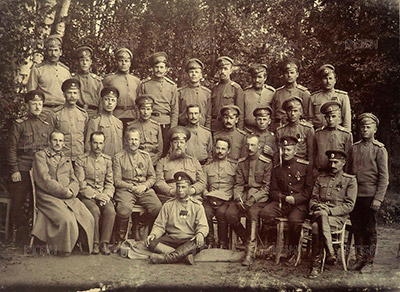
Starting from September 1914 until August 1915 the Russian garrison of the Osowiec fortress complex succeeded to withstand a siege and three attacks of the Germans who were in a large excess over the Russians and even applied chemical weapons.
During the second attack in February 1915 the Germans started almost non-stop gunfiring and bombing from airplanes. And although the Command of the General Staff asked the Commanding Offices to hold out for two days the fortress could hold out for as many as half a year.
The third attempt of the Germans to take Osowiec ended even more dramatically.
After a longtime preparation on June, 24th 1915 the Germans launched a gas attack supported by heavy artillery. The enemies were so secure of victory that they took the rear tracks and prepared the so called funeral teams for the dead of the opposing side. The loss of the Russian garrison was enormous, by the time the Germans had approached the number of the protectors was 160-200 people. Those Russians who survived managed to put up such a good struggle accompanied by gunfiring and counterattacks that the shocked enemy had to retreat.
What had happened was for the first time in the war history. Heroic stand at Osowiec did not let the enemy break the frontline in Belostock direction; it saved the Russian Army from the approaching catastrophe.
Memory of I.M. Zagaynov
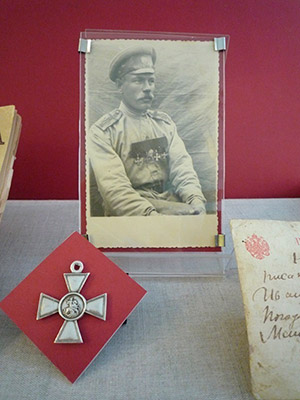
Ilya Mikhailovich Zagaynov was born in 1885 in Shlomovo village, the Kotelnych County (now Yurievskoe village, the Kirov Region). Awarded with two silver and two gold St. George’s Crosses during the World War I. Killed in a battle outside Russia on June 5th 1916.
In August of 1916 his widow managed to bring back his remains and bury them in his home country. However the grave had been forgotten for many years until local historians found it in the post-Soviet period. With the help of the local people in 2012 the grave of the hero was surmounted with a cross.
Honorary mug
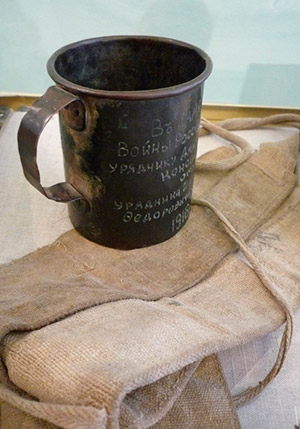
The mug has an engraved signing “To Sergeant Dmitry Efimovich Konovalov from Sergeant Illarion Fedorovich Logachev in the memory of the War between Russia and Germany. 1916”
Such mugs usually served as memorable presents between fellow-soldiers during the times of the World War I. The sighing used to be done right onsite in the regimental blacksmith shops or in rear hospitals.
Handcrafted items made out of war trophies, including those made of shell cases, are of a particular interest. Shell cases from French, English or German standard field guns were often turned into vases decorated by Russian soldiers with patterns or signings.
Volunteer Sologub
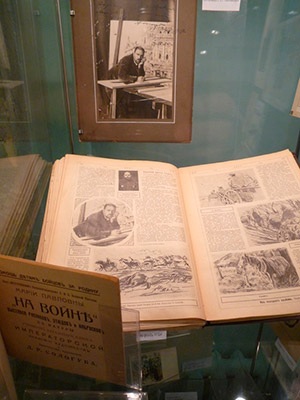
Leonid Romanovich Sologub (1884-1956) worked as an architect and a painter, participated in the World of Art Group. He studied in the Moscow School of Arts, Sculpture and Architecture and at the architecture department of Saint Petersburg Art Academy.
He joined the Army as a volunteer in 1914. During one of the battle’s artillery bombardment he made a panorama sight of the enemy’s battery which helped stop the attack. He was awarded with the 4th Class St. George’s Cross no. 195852.
Wartime sketches made by Sologub were published in the “Niva” magazine and served as a basis for the exhibition “At the War” that took place in the Emperor’s Academy of Arts in December, 1916.
Sologub was discharged in 1918 in the rank of Staff Captain and in 1919 emigrated from Russia.
Cossack Kryuchkov
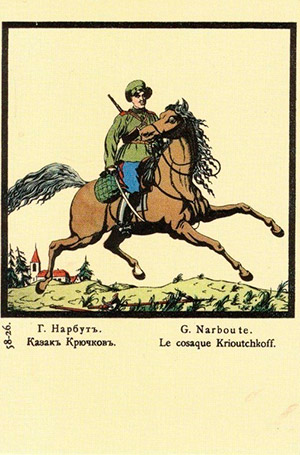
Don Cossack Kozma Firsovich Kryuchkov (1890-1919) became the first Companion of the St. George’s Cross during the times of the World War I. In August 1914 he managed to crush the enemy’s unit of 11 men only with a saber and a pike thus getting 16 wounds.
His heroic act became wide-known and he himself was made a people’s hero. His portrait was printed on postcards, posters, crude colored woodcuts, his heroic deed became the subject of many songs. Even cigarettes and sweets were named “Kozma Kryuchkov”.
During the War he was awarded with four St. George’s Crosses and three St. George’s Medals. In 1919 he was killed in a battle fighting on the side of the Volunteer Army.
The exposition included postcards and magazines with his portrait and also the music text of the Cossack song “Cossack Kryuchkov”.
Sister of Mercy
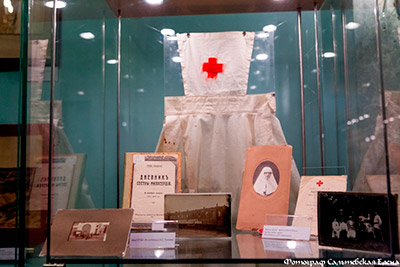
Mariam Alievna Sainova (1897-1988) graduated from Kazan Marian gymnasium in 1914. When the War began she and her sister started working in the Kazan Muslim Hospital. Her brother joined the Army and never came back from the War.
In Kazan City Hospital no.43 the number of wounded soldiers grew larger and larger, the soldiers received treatment and went back to the frontline and sent warm and touching letters to Mariam:
“…Dear sister… How are you? I am missing you so much. Please, write to me! Yasha.”
“Kind sister… I remembered your farewell glance there at the railway station... I hope to see you again… S.T.”
“I wish you a happy holiday and happiness. I am going to the site. Please, send me a postcard if you can. Kostya.”
Mariam Alievna had a long life full of difficulties but through all the years she kept her white apron with a red cross and a pack of photographs dated 1915 which she handed over to her grandchildren.
Red Cross
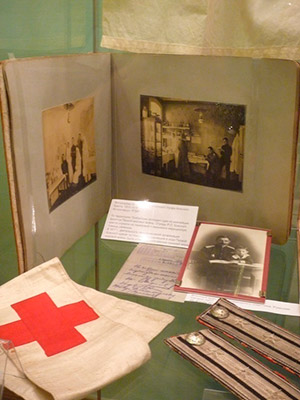
The flag of the Red Cross Society united tens of thousands of volunteers during the World War I. Donations from all parts of the country were coming to the Society. The Red Cross was responsible for supplying organizations that helped refugees, coordinated their movements.
Meal and dressing stations of the Russian Red Cross Society (the RRC) in the fields and in the rear were supplying the wounded with hot meals, tea, MREs, provided medical help. Its work was accompanied by the Central information desk for war prisoners.
In 1915 the Germans applied chemical warfare agents on the frontline for the first time. The RRC could quickly set up the production of filtered gas masks invented by N.D. Zelinsky and in the three months’ time produced about 6 millions of them.
The wounded were transported in ambulance trains, medical service vessels of the RCC and automobiles driven by private individuals.
In 1917 the activity of the International Red Cross Society for helping the sufferers of the World War I was honored with the Nobel Peace Prize.
Based on the materials of the Russian Red Cross Society’s web-site.
Young volunteers
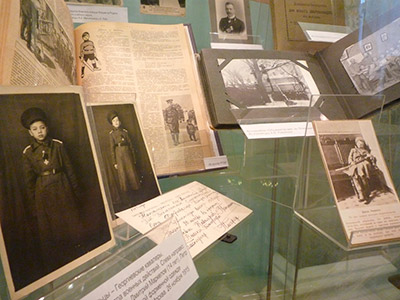
From the report made by the administration of the hostel for young volunteers in Moscow, 1915:
“The Great European War had its influence on the children’s psychic so easily apt to imagination and craving for thrills. So right in the beginning of the War the children of all social classes start running away from their homes to join the Army”.
Due to the efforts made by the Grand Duchess Elizaveta Fedorovna the special organization for providing temporary shelter, alimentation, education and upbringing for young volunteers was created in Moscow in 1915. Many of the young volunteers already had awards and had been previously wounded. It is known that there were 45-50 boys who lived and studied in the hostel. The hostel worked until 1917.
Here is the story of one of the boys, Nikolay Smirnov, aged 11:
“I lived with my aunt; my grandfather was a farmer. I chose a day when a serial was nearby. I ran home, put on a cloak and rushed to the station to go with a Cossack to the site. I was at the battles at Łomża, Przasnysz and Shlock”.
Yaitsk Cossack
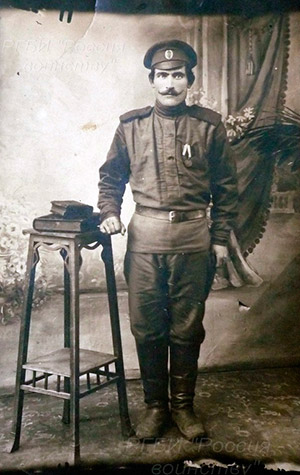
The Story of G.A. Polivtsev’s granddaughter:
“My grandfather, Grigory Arkhipovich Polivtsev (12.02.1891 – 01.10.1943), was a Yaitsk Cossack . He fought since 1914 as a part of 1st Orenburg Cossack Regiment of His Imperial Majesty heir of the Crown Prince of the Russian Empire. In 1914-1918 he served under the direction of the Ataman of Orenburg Cossack Army Alexander Ilyich Dutov. Awarded with 2nd Class Silver St. George’s Cross.
He received his first award - Silver St. George’s Cross – in 1910 when he had served in the 31st Border Brigade of Amu Darya patrolling the borders of Russia”.
14 year-old volunteer Hugo
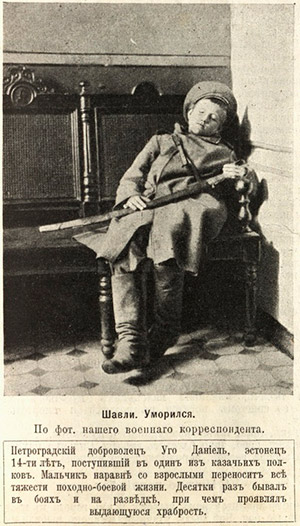
"Hugo Daniel, a 14 year-old Estonian volunteer from Petrograd, serving in one of the Cossack Regiments. On an equal basis with adults he suffered all the difficulties of travel and battlefield life. He took part in battles and operational reconnaissance dozens of times where he displayed an outstanding courage”.
Typical photos of the Wartime show young boys at war. Children’s running-away to the frontline became a real epidemic. Kids were taken off the trains, sent back to their places but they still managed to get to the frontline again and bravely fought just like adults. Their heroism was a constant subject of newspapers and magazines. Many of those kids were wounded and killed. Many of them had no home to come back to. The War had become their way of life.
“… All multimillion children’s community of Europe and Asia is involved in war now. What will happen to this fatal generation growing up among explosions and fires?” (Chukovsky K., Children and War//Niva. – 1915. - № 51. – p. 949 – 953).
Parsifal
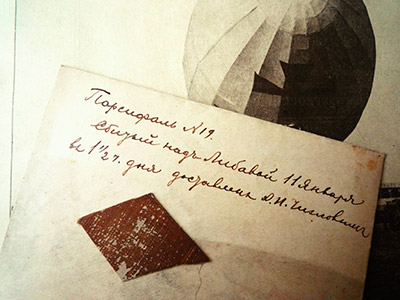
German guided sea aerostat “Parsifal” no.19 assaulted the peaceful town of Libau on January 12th 1915 in order to bomb military assets and then was put down and sunk in the sea. For destroying the aerostat which cost 700.000 marks the whole crew of the harbor craft was awarded with St. George’s Crosses and medals.
M.F. Bokov, Captain of Cavalry of Border Guard, together with several soldiers and experienced fishermen voluntarily raised and delivered the aerostat to the shore. Parts of the aerostat’s skinning were kept (taken by the participators of the operation) as an ordinary war trophy.
Keep this image...
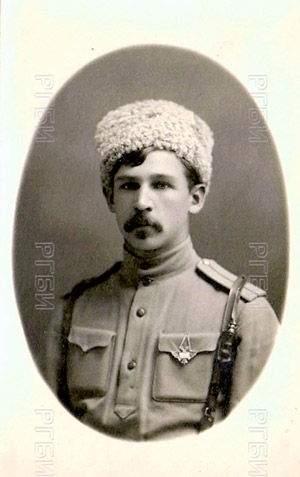
The signing on the back side: “Remember, do not forget and keep this image like the apple of your eye. I. Pichugin”.
Ivan Ivanovich Pichugin (1890 – 1967), graphic artist, illustrator. Member of Moscow Union of Artists.
As a teenager worked in the printing house of I.D. Sytin who noticed the talent of a young worker and sent him to study painting to Sorrento, Italy.
When the War began Ivan Ivanovich Pichugin graduated from the School of warrant officers and went to the frontline. This jocular signing was addressed to his brother Vsevolod Ivanovich Pichugin who served in the cavalry.
After the War Pichugin illustrated children’s books and created slidefilms, including one famous fairytale “Aladdin’s Magic Lamp” (1939) and a slidefilm “The Tale of the Golden Cockerel” (1930s)
Buried at Donskoye Cemetery in Moscow.




